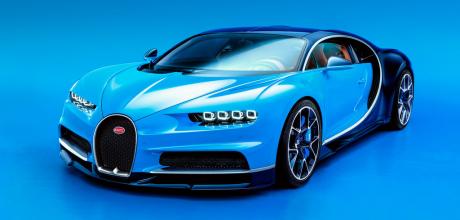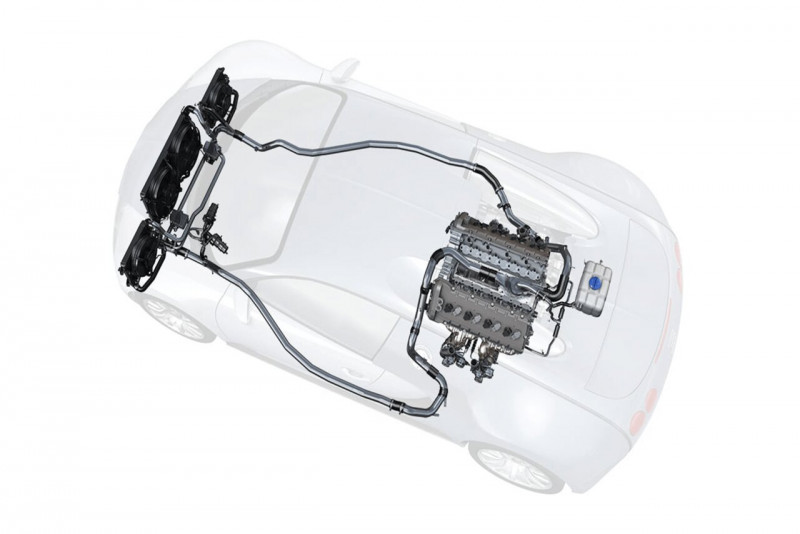Bugatti Chiron cooling system

We investigate the function of modern vehicle cooling systems and their role in ensuring reliability and operating efficiency.
Techtalk Feature: Vehicle cooling systems
Keeping it cool
In internal combustion engines, the conversion of the chemical energy of fuel into kinetic energy creates heat as a waste product. This heat, along with the heat created by the friction of various moving components, needs to be reliably controlled and dissipated to protect the engine and its components.
AIR COOLING OR WATER COOLING?
The earliest motor vehicles featured simple air-cooled engines, but it wasn’t long before a switch to water cooling began. Early water-cooling systems were not reliable in extreme conditions. Engine damage owing to coolant water freezing, or overheating under high load conditions were the norm.
While water-cooling systems were being further developed to improve their reliability and efficiency, several manufacturers continued with air-cooled engines, enjoying the benefits of simplicity, cost, reliability and lower weight. The most well known were the Volkswagen Beetle – which was produced until 2003 – and the Porsche 356/911 models, the air-cooled 993 version in production until 1998. Other manufacturers of air-cooled cars included Chevrolet, Citroën, Fiat, Honda and Tatra but over time, the disadvantages of their higher engine noise levels – no water jackets to absorb the mechanical noise – and cooling difficulties at high specific power outputs, led to a decline in their usage. Ultimately, the challenge of compliance with exhaust emission standards effectively ended the use of air-cooled engines in cars and usage is now generally limited to aircraft, motorcycles and special applications.
What is referred to as water cooling is, in fact, a combination of water and air cooling; water is circulated through the engine to absorb heat but that water is then circulated through a water-air heat exchanger, or radiator, to dissipate its heat to the ambient air. Being reliant on airflow, radiators were commonly mounted at the front of the vehicle and dominated front-end styling. To distinguish their vehicles from others, designers adopted distinctive radiator shapes and finishes, with radiator caps often decorated with unique emblems. Many of these designs became so synonymous with the brand that when radiators were covered by bodywork, the designs were transferred to the bodywork air apertures, radiator grilles. Rolls-Royce, Bentley and Bugatti are among the manufacturers with current radiator grilles that still feature elements from early radiator designs.
RECENT DEVELOPMENTS
In recent years, water-cooling system development has switched to increasingly precise thermal management of coolant and engine temperature, for better control of exhaust emissions and fuel consumption.
Modern developments around thermal management include the adoption of radiator shutters to control radiator airflow, variable speed radiator cooling fans, electronically controlled coolant system thermostats and electric coolant pumps, use of engine coolant to control transmission heating/cooling, coolant-cooled intercoolers, exhaust gas cooling, and even fuel cooling.
BUGATTI CHIRON – 10 RADIATORS
Before examining these cooling system components and systems in more detail, it’s interesting to review the cooling system of the Bugatti Chiron, which features a total of 10 radiators and is reputed to be the most sophisticated and highest performance cooling system installed on a sportscar. To put its cooling demands into perspective, the Chiron is fitted with an 8-litre, quadturbo W16 engine, developing up to 1 175 kW and 1 600 N.m in the Super Sport 300+ version. Limited to 420 km/h in standard road specification, it has been certified at 300+ mph (483 km/h) with special tyres fitted. The Chiron is equipped with two water-cooling circuits. The high-temperature circuit features one main and two auxiliary front-mounted radiators with a system capacity of 37 litres, which it circulates at a rate of 800 litres/minute. The low-temperature circuit cools charge air via two air-to-water heat exchangers (intercoolers), providing more consistent cooling in stop-and-go driving than air-to-air intercoolers. This circuit is equipped with one front-mounted radiator and has a water volume of 12 litres. Engine oil is cooled by a separate oil-to-air cooler mounted on the left side of the car, while oil-to-air coolers for the oil of the 7-speed dual-clutch transmission and rear axle differential oil are mounted on the right. A front-mounted oil-to-air cooler cools the hydraulic oil used to control the active aerodynamics and ride height.

ENGINE COOLING
The basic elements of an engine cooling system are the radiator, expansion tank, coolant, water pump, thermostat and cooling fan. Engine cooling is achieved by circulating coolant through galleries cast into the engine block and cylinder head – where it absorbs excess engine heat – and circulating it through the radiator, where heat is exchanged between the coolant and the ambient air.
A modern radiator consists of a pair of injection-moulded plastic tanks linked by an aluminium core, made up of an array of tubes with fins located between them. The open ends of the tubes protrude through, and are soldered to holes in the base plate of each tank, allowing heated coolant from the engine to flow into one tank, through the tubes of the core where it cools, and into the other tank from where it is routed back to the engine. Cores with flat tubes soldered to corrugated fi ns – which feature fi ne gills to increase air turbulence and heat dissipation – are considered most effective. However, cores with stamped, flat fi ns, mechanically joined to round or oval tubes, are less expensive and are used in many applications. The expansion tank is fitted at the highest point of the cooling circuit and acts as a reservoir when the coolant heats and expands. It is fitted with a pressure relief valve to maintain pressure level and keep the air out of the system.
The coolant is a mixture of water, anti-freeze and corrosion inhibitor. The anti-freeze both lowers its freezing point and raises its boiling point to >110°C with a 1,4-bar pressure cap. Coolant flow is by an engine-driven or electric water pump and is regulated by a thermostat to keep coolant and engine temperature as constant as possible, under varying engine loads and ambient temperatures. Normal operating temperatures for most vehicles are between 90 and 105°C. Thermostats are controlled electronically or by a temperature-sensitive element that controls valves to allow coolant to bypass the radiator for quick engine warm up, the blending of cooled and uncooled coolant at part loads, and only cooled coolant to be circulated at high loads. Airflow is regulated by an electric, or an engine-driven, mechanical fan controlled by a temperature- sensitive viscous clutch, which allows fan engagement and speed to vary according to temperature.
OIL COOLING
Oil coolers can be of the oil-to-air type or the oil-to-coolant type. The former has a similar construction to an engine radiator, being made from aluminium and using flat tubes with turbulence inserts and corrugated cooling fins. Oil-to-coolant coolers are typically used for transmission oil cooling and mounted inside the outlet tank of the main radiator. The heat is dissipated to the coolant via a double tube or multiple flat tubes.
INTERCOOLING
The compression of engine intake air by superchargers and turbochargers increases its temperature, which results in a loss of air density, compromising some of the benefits of the forced induction. Cooling the compressed air through an intercooler increases its density and hence the engine’s volumetric efficiency. The lower intake air temperature also reduces the tendency to engine knocking (pre-detonation) and thus eliminates the need to inject excess fuel to cool air intake temperature to prevent this.
Air-to-air intercoolers share a similar construction to aluminium radiators and are typically mounted in front of or alongside the engine radiator at the front of the vehicle, where they benefit from the cooling air fan at low speeds. Air-to-coolant intercoolers as used in the Bugatti, have the advantage of being able to be mounted close to the turbocharger and intake manifold, shortening pipe lengths and improving response. However, the system needs a separate low-temperature coolant circuit with a coolant-to-air heat exchanger, making it heavier and more expensive.
EXHAUST GAS COOLING
Exhaust gas recirculation (EGR) is used in diesel engines to reduce NOx emissions and in petrol engines to reduce exhaust gas temperatures at high engine loads – otherwise achieved by richer mixtures – thus improving fuel economy. EGR coolers reduce the temperature of the recirculated exhaust gases, further improving efficiency.
- 01 Plastic tank, aluminium core radiator.
- 02 Engine oil-to-coolant oil cooler. This mounts between the oil filter and engine.
- 03 Oil-to-air oil cooler.
- 04 Air-to-air intercooler

